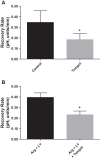Endogenous flow-induced nitric oxide reduces superoxide-stimulated Na/H exchange activity via PKG in thick ascending limbs
- PMID: 25503735
- PMCID: PMC4346749
- DOI: 10.1152/ajprenal.00583.2014
Endogenous flow-induced nitric oxide reduces superoxide-stimulated Na/H exchange activity via PKG in thick ascending limbs
Abstract
Luminal flow stimulates endogenous nitric oxide (NO) and superoxide (O2 (-)) production by renal thick ascending limbs (TALs). The delicate balance between these two factors regulates Na transport in TALs; NO enhances natriuresis, whereas O2 (-) augments Na absorption. Endogenous, flow-stimulated O2 (-) enhances Na/H exchange (NHE). Flow-stimulated NO reduces flow-induced O2 (-), a process mediated by cGMP-dependent protein kinase (PKG). However, whether flow-stimulated, endogenously-produced NO diminishes O2 (-)-stimulated NHE activity and the signaling pathway involved are unknown. We hypothesized that flow-induced NO reduces the stimulation of NHE activity caused by flow-induced O2 (-) via PKG in TALs. Intracellular pH recovery after an acid load was measured as an indicator of NHE activity in isolated, perfused rat TALs. l-Arginine, the NO synthase substrate, decreased NHE activity by 34 ± 5% (n = 5; P < 0.04). The O2 (-) scavenger tempol decreased NHE activity by 46 ± 8% (n = 6; P < 0.004) in the absence of NO. In the presence of l-arginine, the inhibitory effect of tempol on NHE activity was reduced to -19 ± 6% (n = 6; P < 0.03). The soluble guanylate cyclase inhibitor LY-83583 blocked the effect of l-arginine thus restoring tempol's effect on NHE activity to -42 ± 4% (n = 6; P < 0.0005). The PKG inhibitor KT-5823 also inhibited l-arginine's effect on tempol-reduced NHE activity (-43 ± 5%; n = 5; P < 0.03). We conclude that flow-induced NO reduces the stimulatory effect of endogenous, flow-induced O2 (-) on NHE activity in TALs via an increase in cGMP and PKG activation.
Keywords: luminal flow; protein kinases; reactive oxygen species; sodium/hydrogen exchange.
Copyright © 2015 the American Physiological Society.
Figures






Similar articles
-
Endogenous flow-induced superoxide stimulates Na/H exchange activity via PKC in thick ascending limbs.Am J Physiol Renal Physiol. 2014 Oct 1;307(7):F800-5. doi: 10.1152/ajprenal.00260.2014. Epub 2014 Jul 30. Am J Physiol Renal Physiol. 2014. PMID: 25080525 Free PMC article.
-
Nitric oxide reduces flow-induced superoxide production via cGMP-dependent protein kinase in thick ascending limbs.Am J Physiol Renal Physiol. 2009 May;296(5):F1061-6. doi: 10.1152/ajprenal.90707.2008. Epub 2009 Feb 25. Am J Physiol Renal Physiol. 2009. PMID: 19244401 Free PMC article.
-
Flow increases superoxide production by NADPH oxidase via activation of Na-K-2Cl cotransport and mechanical stress in thick ascending limbs.Am J Physiol Renal Physiol. 2007 Mar;292(3):F993-8. doi: 10.1152/ajprenal.00383.2006. Epub 2006 Nov 28. Am J Physiol Renal Physiol. 2007. PMID: 17132867
-
H+ and HCO3- transporters in the medullary thick ascending limb of the kidney: molecular mechanisms, function and regulation.Kidney Int Suppl. 1998 Apr;65:S36-41. Kidney Int Suppl. 1998. PMID: 9551430 Review.
-
Nitric oxide and superoxide in the renal medulla: a delicate balancing act.Curr Opin Nephrol Hypertens. 2005 Jan;14(1):9-15. doi: 10.1097/00041552-200501000-00003. Curr Opin Nephrol Hypertens. 2005. PMID: 15586010 Review.
Cited by
-
Oxidative Stress-Activated NHE1 Is Involved in High Glucose-Induced Apoptosis in Renal Tubular Epithelial Cells.Yonsei Med J. 2016 Sep;57(5):1252-9. doi: 10.3349/ymj.2016.57.5.1252. Yonsei Med J. 2016. PMID: 27401659 Free PMC article.
-
Claudin-19 mediates the effects of NO on the paracellular pathway in thick ascending limbs.Am J Physiol Renal Physiol. 2019 Aug 1;317(2):F411-F418. doi: 10.1152/ajprenal.00065.2019. Epub 2019 Jun 5. Am J Physiol Renal Physiol. 2019. PMID: 31166708 Free PMC article.
-
NADPH oxidase 4-derived superoxide mediates flow-stimulated NKCC2 activity in thick ascending limbs.Am J Physiol Renal Physiol. 2018 May 1;314(5):F934-F941. doi: 10.1152/ajprenal.00631.2017. Epub 2018 Apr 19. Am J Physiol Renal Physiol. 2018. PMID: 29672130 Free PMC article.
References
-
- Abe M, O'Connor P, Kaldunski M, Liang M, Roman RJ, Cowley AW Jr.. Effect of sodium delivery on superoxide and nitric oxide in the medullary thick ascending limb. Am J Physiol Renal Physiol 291: F350–F357, 2006. - PubMed
-
- Alpern RJ, Cogan MG, Rector FC Jr.. Flow dependence of proximal tubular bicarbonate absorption. Am J Physiol Renal Fluid Electrolyte Physiol 245: F478–F484, 1983. - PubMed
-
- Araujo M, Welch WJ. Oxidative stress and nitric oxide in kidney function. Curr Opin Nephrol Hypertens 15: 72–77, 2006. - PubMed
-
- Arendshorst WJ, Beierwaltes WH. Renal tubular reabsorption in spontaneously hypertensive rats. Am J Physiol Renal Fluid Electrolyte Physiol 237: F38–F47, 1979. - PubMed
-
- Baer PG, Bianchi G, Liliana D. Renal micropuncture study of normotensive and Milan hypertensive rats before and after development of hypertension. Kidney Int 13: 452–466, 1978. - PubMed
Publication types
MeSH terms
Substances
Grants and funding
LinkOut - more resources
Full Text Sources
Other Literature Sources
Molecular Biology Databases

